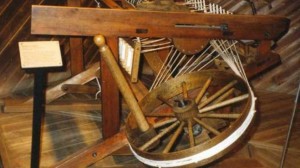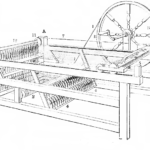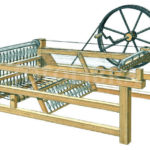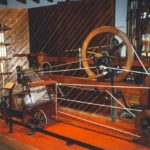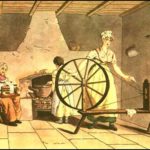How Do Spinning Jenny Work
A key development in the industrial revolution of England, the spinning jenny allowed yarn to be manufactured in large quantities.
The spinning jenny – the world’s first industrial spinning frame – worked by connecting multiple spindles and multiple rovings (a long, narrow bundle of fibre) to the end of a fixed wooden frame.
Onto these spindles numerous rove threads were affixed, extended down its length and clamped between two movable horizontal bars that when drawn towards the spinner extended the thread in straight lines.
This motion was partnered with a twisting motion generated by turning a wheel attached to the frame, revolving the spindles and spinning the thread into yarn.
Individual thread streams were separated by a vertical wire system referred to as a faller, which dropped down between the lines and ensured they remained unconnected.
At the culmination of the drawing out of the thread and the rotation of the wheel, the clasp bars returned to their original position and the yarn was deposited onto the spindles.
![How do Spinning Jenny Work How do Spinning Jenny Work]() Facts about Spinning Jenny
Facts about Spinning Jenny
Jenny who? – Many believe that inventor James Hargreaves named the machine after his daughter. In fact, none of his daughters were named Jenny according to registers.
Smash and run – Fuelled by the jenny’s ability to produce lots of yarn quicker and cheaper than traditional methods, the price of yam fell dramatically in Hargreaves’ local area, inciting the spinning community to ransack his house and smash his machines.
 Doubling up – The efficiency of the spinning jenny was an answer to high early-18th Century demand, as it was needed by weavers whose productivity had doubled from the invention of the flying shuttle in 1733.
Doubling up – The efficiency of the spinning jenny was an answer to high early-18th Century demand, as it was needed by weavers whose productivity had doubled from the invention of the flying shuttle in 1733.
Maximum spool – Hargreaves’ original design of the spinning jenny allowed its operator to work eight spools at once. As the design evolved, the spools increased massively, often exceeding 100 to 120.
Spinning mule – The jenny was succeeded in the early-19th Century by the spinning mule, a more advanced system that affixed the spindles to the carriage and a creel of roving bobbins on the frame.
Read also on other sites: Production During Industrial Revolution , James Hargreaves (1720-1778) , What Is a Spinning Machine?
At the very beginning, Hargreaves was hiding machine from the public but had to produce few of them for his own needs. In 1768 someone broke into his factory and destroyed the machine completely, after which he moved to Nottingham, which was at that time the center of industry.
In 1770 he submitted an application for a patent, calling him Spinning Jenny – a machine for spinning, drawing and twisting of cotton.
Several copies of his machine appeared, and Hargreaves tried to sue them, but the lawsuit was dismissed because it turned out to have sold several copies in secret before filing a patent application.
The machine was kept in the cotton industry until 1810 when it was replaced with a more advanced machine named spinning mule, invented by Samuel Crompton.

